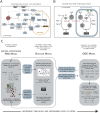Multi-scale model suggests the trade-off between protein and ATP demand as a driver of metabolic changes during yeast replicative ageing
- PMID: 35797415
- PMCID: PMC9295998
- DOI: 10.1371/journal.pcbi.1010261
Multi-scale model suggests the trade-off between protein and ATP demand as a driver of metabolic changes during yeast replicative ageing
Abstract
The accumulation of protein damage is one of the major drivers of replicative ageing, describing a cell's reduced ability to reproduce over time even under optimal conditions. Reactive oxygen and nitrogen species are precursors of protein damage and therefore tightly linked to ageing. At the same time, they are an inevitable by-product of the cell's metabolism. Cells are able to sense high levels of reactive oxygen and nitrogen species and can subsequently adapt their metabolism through gene regulation to slow down damage accumulation. However, the older or damaged a cell is the less flexibility it has to allocate enzymes across the metabolic network, forcing further adaptions in the metabolism. To investigate changes in the metabolism during replicative ageing, we developed an multi-scale mathematical model using budding yeast as a model organism. The model consists of three interconnected modules: a Boolean model of the signalling network, an enzyme-constrained flux balance model of the central carbon metabolism and a dynamic model of growth and protein damage accumulation with discrete cell divisions. The model can explain known features of replicative ageing, like average lifespan and increase in generation time during successive division, in yeast wildtype cells by a decreasing pool of functional enzymes and an increasing energy demand for maintenance. We further used the model to identify three consecutive metabolic phases, that a cell can undergo during its life, and their influence on the replicative potential, and proposed an intervention span for lifespan control.
Conflict of interest statement
The authors have declared that no competing interests exist.
Figures




Similar articles
-
The choice of the objective function in flux balance analysis is crucial for predicting replicative lifespans in yeast.PLoS One. 2022 Oct 13;17(10):e0276112. doi: 10.1371/journal.pone.0276112. eCollection 2022. PLoS One. 2022. PMID: 36227951 Free PMC article.
-
Synergistic effects of repair, resilience and retention of damage determine the conditions for replicative ageing.Sci Rep. 2020 Jan 31;10(1):1556. doi: 10.1038/s41598-020-58444-2. Sci Rep. 2020. PMID: 32005954 Free PMC article.
-
Cellular redox homeostasis, reactive oxygen species and replicative ageing in Saccharomyces cerevisiae.FEMS Yeast Res. 2014 Feb;14(1):60-72. doi: 10.1111/1567-1364.12114. Epub 2013 Nov 8. FEMS Yeast Res. 2014. PMID: 24164795 Review.
-
The effects of reactive oxygen and nitrogen species during yeast replicative ageing.Biofactors. 2006;27(1-4):185-93. doi: 10.1002/biof.5520270116. Biofactors. 2006. PMID: 17012774
-
Longevity pathways and maintenance of the proteome: the role of autophagy and mitophagy during yeast ageing.Microb Cell. 2014 Apr 7;1(4):118-127. doi: 10.15698/mic2014.04.136. Microb Cell. 2014. PMID: 28357232 Free PMC article. Review.
Cited by
-
Evaluating plant growth-defense trade-offs by modeling the interaction between primary and secondary metabolism.Proc Natl Acad Sci U S A. 2025 Aug 12;122(32):e2502160122. doi: 10.1073/pnas.2502160122. Epub 2025 Aug 7. Proc Natl Acad Sci U S A. 2025. PMID: 40773226 Free PMC article.
-
Metabolic Objectives and Trade-Offs: Inference and Applications.Metabolites. 2025 Feb 6;15(2):101. doi: 10.3390/metabo15020101. Metabolites. 2025. PMID: 39997726 Free PMC article. Review.
-
The choice of the objective function in flux balance analysis is crucial for predicting replicative lifespans in yeast.PLoS One. 2022 Oct 13;17(10):e0276112. doi: 10.1371/journal.pone.0276112. eCollection 2022. PLoS One. 2022. PMID: 36227951 Free PMC article.
References
Publication types
MeSH terms
Substances
LinkOut - more resources
Full Text Sources
Molecular Biology Databases

